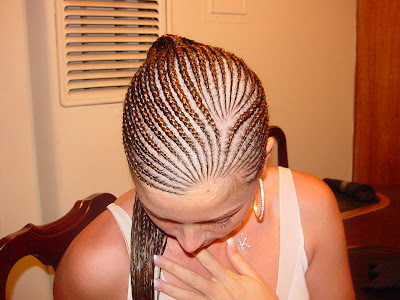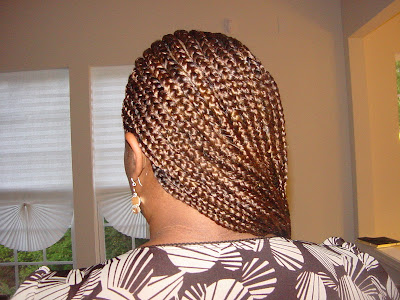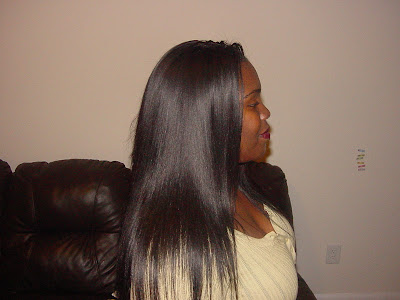
Visit me at
www.kristenlock.com to learn how to get my DVD that will teach you how to do many of the techniques you see here on my blog.
Hair straightening chemicals not linked to breast cancer risk in African-Americans
May 17, 2007
PHILADELPHIA - Chemical "relaxers" used to straighten hair are not associated with an increased risk of developing breast cancer among African-American women, say researchers who followed 48,167 Black Women's Health Study participants.
In the May issue of Cancer Epidemiology, Biomarkers & Prevention, researchers from Boston University and Howard University Cancer Center found no increase in breast cancer risk due to the type of hair relaxer used or the frequency and duration of use. Women who used relaxers seven or more times a year over a 20 year span or longer had the same risk as women who used the chemicals for less than a year, researchers say.
"This is good news," said the study's lead investigator, Lynn Rosenberg, Sc.D., professor of epidemiology at Boston University School of Public Health. "The present study is definitive that hair relaxers don't cause breast cancer, as much as an epidemiologic study can be."
Previous research shows that breast cancer incidence is higher among African-American women age 40 or younger than among Caucasian women of the same age, and this increased risk is not fully explained by known risk factors, such as race and family history. At all ages, African-American women are more likely to die of breast cancer than are Caucasian women. To shed light on these findings and to study potential causes of breast cancer and other serious illnesses that affect black women, the Black Women's Health Study was launched across the United States in 1995. More than 59,000 women completed an initial questionnaire and more than 80 percent have answered follow-up questions every two years since, including questions about use of hair relaxers.
Hair relaxers can enter the body through cuts or lesions in the scalp. These products are not fully monitored by the Food and Drug Administration, and thus could contain potentially harmful compounds, Rosenberg said. Manufacturers of hair relaxers and hair dyes are not required to list all ingredients of their products on the packages, as some may be considered trade secrets, she said.
"Because hair relaxers are more widely used by younger African-American women than they are used by older African-American women, a connection with increased risk of breast cancer in younger women seemed possible," Rosenberg said. "Also, millions of African-American women use hair relaxers, and substances that are used by millions of women over a span of many years should be monitored for safety."
The researchers found that younger women used hair relaxers more than older women did. They also discovered that the majority of women used hair relaxers before age 20 and a third used the chemicals at least seven times a year. But when they examined the association between use of hair relaxers and breast cancer, based on 574 newly diagnosed cases of breast cancer identified during the follow-up period, they found no connection between use of relaxers and breast cancer incidence overall or among the younger women, even if use had been frequent and of long duration.
The study was funded by the National Cancer Institute. Co-authors include Julie Palmer, Sc.D., and Deborah Boggs, M.S., of Boston University School of Public Health, and Lucile Adams-Campbell, Ph.D., of Howard University Cancer Center.
###
The mission of the American Association for Cancer Research is to prevent and cure cancer. Founded in 1907, AACR is the world's oldest and largest professional organization dedicated to advancing cancer research. The membership includes nearly 26,000 basic, translational, and clinical researchers; health care professionals; and cancer survivors and advocates in the United States and more than 70 other countries. AACR marshals the full spectrum of expertise from the cancer community to accelerate progress in the prevention, diagnosis and treatment of cancer through high-quality scientific and educational programs. It funds innovative, meritorious research grants. The AACR Annual Meeting attracts more than 17,000 participants who share the latest discoveries and developments in the field. Special Conferences throughout the year present novel data across a wide variety of topics in cancer research, treatment, and patient care. AACR publishes five major peer-reviewed journals: Cancer Research; Clinical Cancer Research; Molecular Cancer Therapeutics; Molecular Cancer Research; and Cancer Epidemiology, Biomarkers & Prevention. Its most recent publication, CR, is a magazine for cancer survivors, patient advocates, their families, physicians, and scientists. It provides a forum for sharing essential, evidence-based information and perspectives on progress in cancer research, survivorship, and advocacy.
 Visit me at www.kristenlock.com to learn how to get my DVD that will teach you how to do many of the techniques you see here on my blog.
Visit me at www.kristenlock.com to learn how to get my DVD that will teach you how to do many of the techniques you see here on my blog. Here is one of my favorite braiding styles to do. I again used the feed-in technique to achieve this look. I used about 2 packs of synthetic hair. I like this method a lot because it puts less stress on the client’s edges which eliminates the issue that the knot cornrows cause by pulling out the client’s edges. With the feed in technique you will not have to worry about having your hair pulled out no matter how weak your edges are. I believe in the preservation of hair; I don't want you hair to only look nice in the style I do, I want it to look nice when it is time to take them out!. If you would like to have me do your feed-in cornrows please email me at kristen.braids@gmail.com.
Here is one of my favorite braiding styles to do. I again used the feed-in technique to achieve this look. I used about 2 packs of synthetic hair. I like this method a lot because it puts less stress on the client’s edges which eliminates the issue that the knot cornrows cause by pulling out the client’s edges. With the feed in technique you will not have to worry about having your hair pulled out no matter how weak your edges are. I believe in the preservation of hair; I don't want you hair to only look nice in the style I do, I want it to look nice when it is time to take them out!. If you would like to have me do your feed-in cornrows please email me at kristen.braids@gmail.com. 
















































